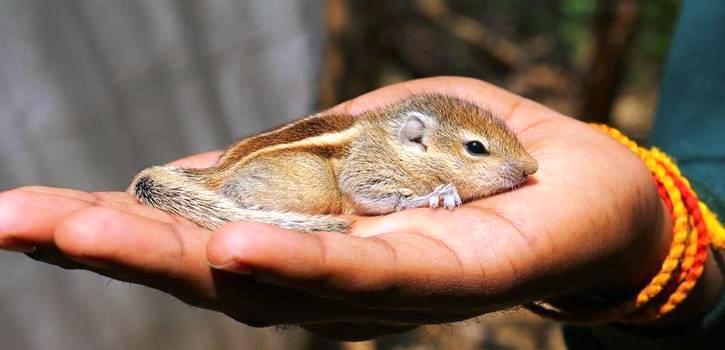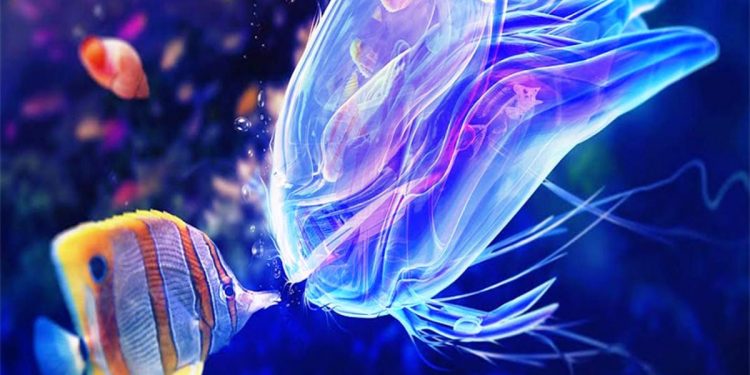Maneka Gandhi
I have just spent a week in monsoon-washed Goa, without going to the beach. The reason for this sacrilege? Jellyfish. The Goa government has issued a warning to beachgoers that the beaches and coastal waters have swarms of live and dead jellyfish. These long tentacled gelatinous marine creatures are beautiful and deadly.
There are over 1,200 known varieties of jellyfish. They range from tiny ones that you can ingest while swimming, to those weighing 200 kilos. The Blue Bottle and Portuguese Man-of-War jellyfish, currently invading Indian coasts, have nematocysts on their long tentacles (going up to 10 feet) — microscopic barbed stinging structures which can pierce human beings and inject venom. Dead jellyfish washed out on to the beach can do it as well, as nematocysts remain potent in moist conditions for months.
The victim may experience skin irritation, muscle cramps, headache, nausea, diarrhea and fever. In extreme cases it can cause acute pain, breathing difficulty, heart attacks and even death. One is more likely to die from a jellyfish sting than a shark attack.
As the jellyfish population spins out of control, beaches have become dangerous for humans. Every year, thousands of people are stung. The beaches of Mumbai, Goa, Kerala, Tamil Nadu and Andhra Pradesh were a problem in the monsoon. Now there are invasions throughout the year. A jellyfish bloom has been reported off Visakhapatnam coast for the first time.
Australia and Southeast Asia have the dreaded box jellyfish, whose venom causes the heart to seize. In the Philippines 20-40 people die annually from box jellyfish stings.
The Irukandji is the size of a sugar cube and its stinger leaves no trace. Ten minutes after contact, victims suffer excruciating pain in the lower back, they start vomiting incessantly, their airways get constricted, clots occur in the brain and hearts fail. “It is difficult to know how many victims the Irukandji have claimed,” writes biologist Tim Flannery. “Many deaths have been put down to stroke, heart attack or drowning.”
Some 150,000 people are now treated for jellyfish stings in the Mediterranean each summer. Jellyfish don’t just sting, they have a huge economic and ecological impact. They are wreaking havoc all around the world by disrupting food chains, causing massive power plant outages, jeopardising fisheries and tourism potential.
Jellyfish eat plant plankton and ichthyoplankton — the eggs and larvae of fish — as well as young fish, reducing fish populations. They can eat 10 times their body weight daily.
In the 1980s, a severe outbreak of comb Jellyfish, brought from America in the ballast water of foreign ships to the Black Sea, eliminated mackerel and anchovy, and collapsed the $350 million Black Sea fishing industry. The jellyfish preyed on anchovy eggs and larvae and consumed the same zooplankton that the anchovies ate. Soon the anchovy fishery crashed and the jellyfish bloomed. By 1993 it was 95 per cent of the total biomass of the Black Sea.
Jellyfish now swarm all over. Fishermen nets in India are clogged with jellyfish. Estuaries in Kerala are often choked with heavy swarms. Fishing vessels operating near the shore net huge quantities of jellyfish.
Nuclear and thermal power plants use coastal waters for cooling, and discharge the heated water back into the seas. This increases temperatures by 1 to 1.5C and affects waters for hundreds of miles. Jellyfish increase in heated waters. The atomic power station at Kalpakkam in Tamil Nadu suffered reduced production efficiency due to swarms of jellyfish clogging the sea water intake piping. On occasion, the plant has even been forced to stop production entirely. Similar stories have been reported from power plants in the USA, Sweden, China and Japan where clogging has caused emergency situations at nuclear power plants and resulted in major power cuts and economic damage to cities. Nuclear plants in Japan are regularly shut down by jellyfish. In 1999 half of the Philippines lost power. The Persian Gulf systems of desalination power plant and liquid natural gas plant have been affected by blooms since 2000. Throngs of jellyfish have disrupted power generation everywhere from Muscat to Maryland, from South Korea to Scotland.
Jellyfish have been around for centuries. Why are we facing overpopulation now?
Jellyfish thrive on ecosystems in distress. Biologist Lisa-Ann Gershwin writes: “As seas become stressed, the jellyfish are there, like an eagle to an injured lamb – more than just as symptom of weakness, more like the angel of death.”
It is entirely our fault. The human race has created conditions leading to an explosion of jellyfish blooms around the world.
The waste from farms and human settlements are thrown into waters that lead to the ocean. This leads to “eutrophication”, which comes from the Greek eutrophos, for “well-nourished”. Nitrates and phosphates from sewage and fertilisers cause plants, such as algae and phytoplankton, to flourish to such an extent that the whole surface of the dam, river or ocean is covered. This thick green algae at the surface blocks sunlight from reaching aquatic plants and marine creatures, killing them. Oxygen levels drop as the algae take oxygen from the water, causing the death of fish and molluscs. The water is acidified. This environment suits jellyfish who thrive. While killing larger fish, eutrophication supports the survival of plankton, larval sardines and other organisms, which the Jellyfish feed on. The increase in jellyfish population has been found to match the increase in the occurrence of algal blooms in the coastal waters. Eutrophication reduces water clarity and light penetration. This benefits jellyfish. Fish are visual feeders, while jellyfish are non-visual; turbid water reduces feeding by fish, but does not affect jellyfish. Jellyfish need very little oxygen to survive. So, as other animals dwindle, jellyfish colonies expand.
Overfishing by humans has reached catastrophic levels and has led to a situation where most natural predators of jellyfish, such as sea turtles, salmon, mackerel, bluefin tuna, pilot whales and albatross, have become scarce. Jellyfish are eaten by 120 species of fish and 30 marine animals, including mushroom corals. Unfortunately, these fish are commercially fished. Their competitors for plankton and small fish, such as billfish and dolphins, are also endangered. Sea turtles, particularly leatherbacks and loggerheads, are suffocating on plastic in the ocean.
So jellyfish get a free run of the ocean and its small fish and larvae.
Overfishing has also made enormous room for plankton to grow. Fish such as anchovies, sardines and menhaden, which are plankton eaters, are harvested for fish meal for aquaculture. Plankton is the favourite food of jellyfish and now they have no competitor. By devouring huge quantities of plankton, jellyfish also deprive small fish species of food and they stop breeding. A particularly large Nomura’s jellyfish takes in enough seawater each day to fill a swimming pool, gobbling up any plankton it catches in the process. Jellyfish wreak havoc on the entire food chain.
Without a curb on their population, growing hordes of jellyfish start eating the eggs of smaller fish, as well as their food supply. They then occupy the niche that was once filled by other species. In Namibia, catches of anchovy and sardines have reduced dramatically after 1988 and large populations of 2 jellyfishes now predominate.
Aquaculture is increasing the number of jellyfish. The captive fish are free food; from giant shrimps, killed in India’s captive breeding stations, to salmon and trout in Scotland, Ireland and Norway. When additional feed is provided, eutrophication of the waters takes place. The aquaculture structures, like rafts, provide shade for polyps to grow.
Studies show that jellyfish started increasing in the 1980s, but have increased far more dramatically in the last ten years.
Human structures built in the oceans have provided jellyfish with ideal places to reproduce. Jellyfish polyps need a solid structure to stick to, breed, develop and ‘hatch’. They have a variety of options to choose from — embankments, granite seawalls, docks, artificial reefs, floating plastic waste, ships, offshore oil rigs. Even packets of cigarettes, plates and statues of religious idols serve as breading grounds for polyps to stick and grow.
Jellyfish thrive on ecosystems in distress. Biologist Lisa-Ann Gershwin writes: “As seas become stressed, the jellyfish are there, like an eagle to an injured lamb – more than just as symptom of weakness, more like the angel of death.”
We need to urgently change the way we treat our oceans and the beings in it.
First, eutrophication needs to be controlled by reducing the nutrients that we indiscriminately empty into the oceans. Waste needs to go through much more stringent treatment before it can be let out into the sea.
We need to immediately stop overfishing. The huge trawlers, which amass tonnes of fish in one catch and throw away 90% of them as waste need, to be stopped completely. The government should introduce quotes to control the amount of fishing. This will increase the number of predators that feed on jellyfish.
Our permanent interventions in the sea, such as ports, marinas, offshore rigs etc., need to be cleaned regularly so that jellyfish polyps cannot survive on them. In fact, this practice of building in the ocean itself should be discouraged.
I know these solutions seem long term, but unfortunately they are the only ones available. In any case it may be too late and we can’t do much to stop jellyfish from taking over the oceans.
From an evolutionary standpoint, Jellyfish are biologically primed to take over the sea. They reproduce on the sea floor, or any other hard surface, and breed in massive numbers (in thousands/day). These blooms are increasing in intensity, frequency, or duration, says Lucas Brotz, a jellyfish expert at the University of British Columbia. Brotz’s research of 45 marine ecosystems shows an increase of 62% in blooms since 1950.
Will the oceans of the future soon be filled with jellyfish? They are moving closer to becoming the dominant species in the seas, filling the niche of the disappearing fish.
Global temperatures are expected to rise 0.2C during the next 2 decades. Warming of the oceans will increase jellyfish populations. As the climate changes the ocean currents change and blooms will crop up in new locations.
The current world human population is projected to increase 46 per cent by 2050. Human influences and demands on the ocean will increase. Increased demands for energy will drive more dam and power plant construction, causing more sea warming in coastal waters. For example, China has 3 operative nuclear power stations and 4 are under construction. Increased fertiliser use, particularly in Asia, will cause eutrophication to double. Global aquaculture has doubled between 1997 and 2020, with especially large increases occurring in developing nations. More fishing means more coastal development. Therefore, more opportunities for jellyfish, who are skilled at surviving in warm, polluted and acidified waters.
Our oceans’ ecosystem is on the brink. A new ecological system is coming along, with jellyfish at the top of the food chain. Once this stabilises, the removal of its dominance may prove difficult. Fish will almost disappear — even if we stop fishing. Jellyfish will prevent the recovery of overfished populations, by eating their larvae.
Once jellyfish own the ocean, global warming will be even faster. Jellyfish promote climate change by releasing carbon-rich mucous and faecal matter. Marine bacteria use this jellyfish to breed, which creates even more carbon dioxide and methane. “Climate change promotes jellyfish blooms, and jellyfish blooms promote climate change,” Gershwin, the author of ‘Stung’, explains, “and like all robust feedback loops, where it stops nobody knows.”
You will soon be eating jellyfish curry instead of fish. Scientists from eight countries have begun a project called GoJelly to create jellyfish-based products — water filters, fish feed, face cream, fertilisers, food, salt, alcohol and jellyfish ethanol for cars.

To join the animal welfare movement, contact gandhim@nic.in, www.peopleforanimalsindia.org.







































